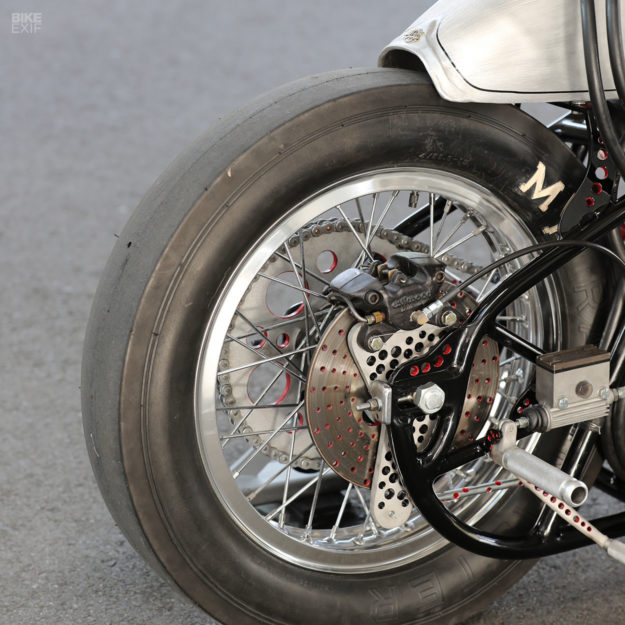
Squeezing two Harley engines into one chassis is a special form of lunacy, most commonly found in the drag bike scene in the USA.
In the glory days of the mid-70s, Bonnie Truett linked a pair of Sportster motors and nitro-injected them. A decade later, Elmer Trett built an even faster twin-engined bike: the ‘Freight Train,’ which ran the quarter mile in under seven seconds.

Despite the wealth of tuning talent in Japan, no double-engined Harley has been built there—until now. Kentaro Nakano is the man who has broken the drought, by creating the engineering masterpiece we’re looking at here.
Nakano-san operates as Hot Chop Speed Shop in Kyoto, and is held in high regard in local Harley circles.

At the Mooneyes show a few weeks ago, his monstrous drag racer scooped awards from two of Japan’s biggest moto magazines—Hot Bike and Vibes. So we asked Mr. Nakano to organize a shoot for us, and he kindly obliged.
“I started the project in December 2017,” he tells us. “It’s a tribute to the drag racers of the 1970s, using Sportster XLCH engines.”

The front engine is a 1969 vintage ironhead, and the engine behind it is a couple of years older. Both mills were thoroughly rebuilt, with help from Nakano’s friend Kazuhiro Takahashi of Sakai Boring.
Fuel is metered through S&S Super B carbs (which first hit the market in 1975) fitted with one-off intake funnels.

Nakano has also changed the timing of the engines, to create gaps between the exhaust pulses. At idle, ‘Double Trouble’ sounds unmistakably like a Harley, we’re informed—but at high rpm, more like a Japanese multi-cylinder engine.
Connecting plates link the V-twins together, and the output shafts are hooked up to two primary drives: one from a current model Sportster, and another from a modern Big Twin tourer.

The transmission is the weak point on a 1960s Sportster, and with two engines in tandem, sticking with the stock gears would result in tears. So Nakano has installed the four-speed ‘box from a 1980s Big Twin.
With the powertrain sorted, Nakano turned his attention to the frame. It’s an entirely custom-built affair, using steel piping, with forks from an early 70s Ducati 750 Imola up front—slightly shaved for a custom look.

The discreet paint is by GRIMB Krazy Painting, which despite the odd name is the go-to shop for many of the top Japanese custom auto and moto builders.
Nakano has selected aluminum wheels, 18 inches front and back, and both with classic H-type rims. They’re shod with drag slicks from M&H, the company that ‘wrote the book on traction.’

He’s installed a front brake from the Minnesota specialist Airheart—a company familiar with the requirements of drag racing—while the back brake is from the Californian firm Wilwood.
The cockpit is simple: one-off drag bars are clamped into a custom top yoke, with a 1970s Harley tachometer just ahead. The levers are one-offs too, but the grips are off-the-shelf Japanese items.

The aluminum bodywork is minimalist in the extreme: a simple cylindrical fuel tank sitting on the frame top tube, and a cowl behind the seat that doubles up as an oil tank.
Atelier Cherry delivered the hand-sewn leather seat pad, which looks as though it’s been in service since the 70s.

‘Double Trouble’ looks fast even standing still. Nakano is going to take it to the Japanese drag strips in the coming months, and with the help of engine builder Takahashi-san, he’ll be recreating the spirit (and hopefully the quarter mile times) of the famous 70s American bikes.
If the results are good, the next step is to find a sponsor and take the bike to the Bonneville Salt Flats for some extreme speed runs.

But first, there’s one more small job Nakano needs to complete before he starts racing: the addition of a supercharger.
“I already have it in stock,” he says …
Hot Chop Speed Shop | Facebook | Instagram | Images by Satoru Ise of Vibes Magazine
